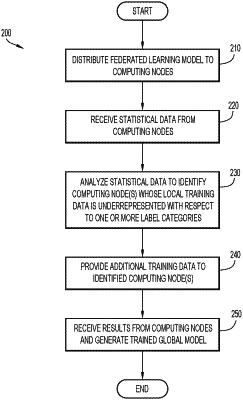| CPC G06F 18/2148 (2023.01) [G06F 17/18 (2013.01); G06F 18/217 (2023.01); G06N 3/08 (2013.01)] | 20 Claims |

|
1. A computer-implemented method for training a federated learning model, the method comprising:
distributing a federated learning model to a plurality of computing nodes, wherein each computing node includes a set of local training data for training the federated learning model comprising data samples each labeled with one label of a plurality of labels;
receiving statistical data from each of the plurality of computing nodes, wherein the statistical data for a computing node is based on the local training data of the computing node, and wherein the statistical data indicates a count of data samples for each label;
analyzing the statistical data to identify one or more computing nodes having local training data in which a ratio of a count of data samples for one or more labels to a count of data samples for a most-represented label in the local training data is below a threshold value;
providing additional training data to the identified one or more computing nodes, wherein the additional training data comprises data samples labeled with labels other than the most-represented label, and wherein the identified one or more computing nodes train the federated learning model using the set of local training data and the additional training data; and
receiving results from the plurality of computing nodes in response to the plurality of computing nodes each locally training the federated learning model, and generating a trained global model based on the results.
|